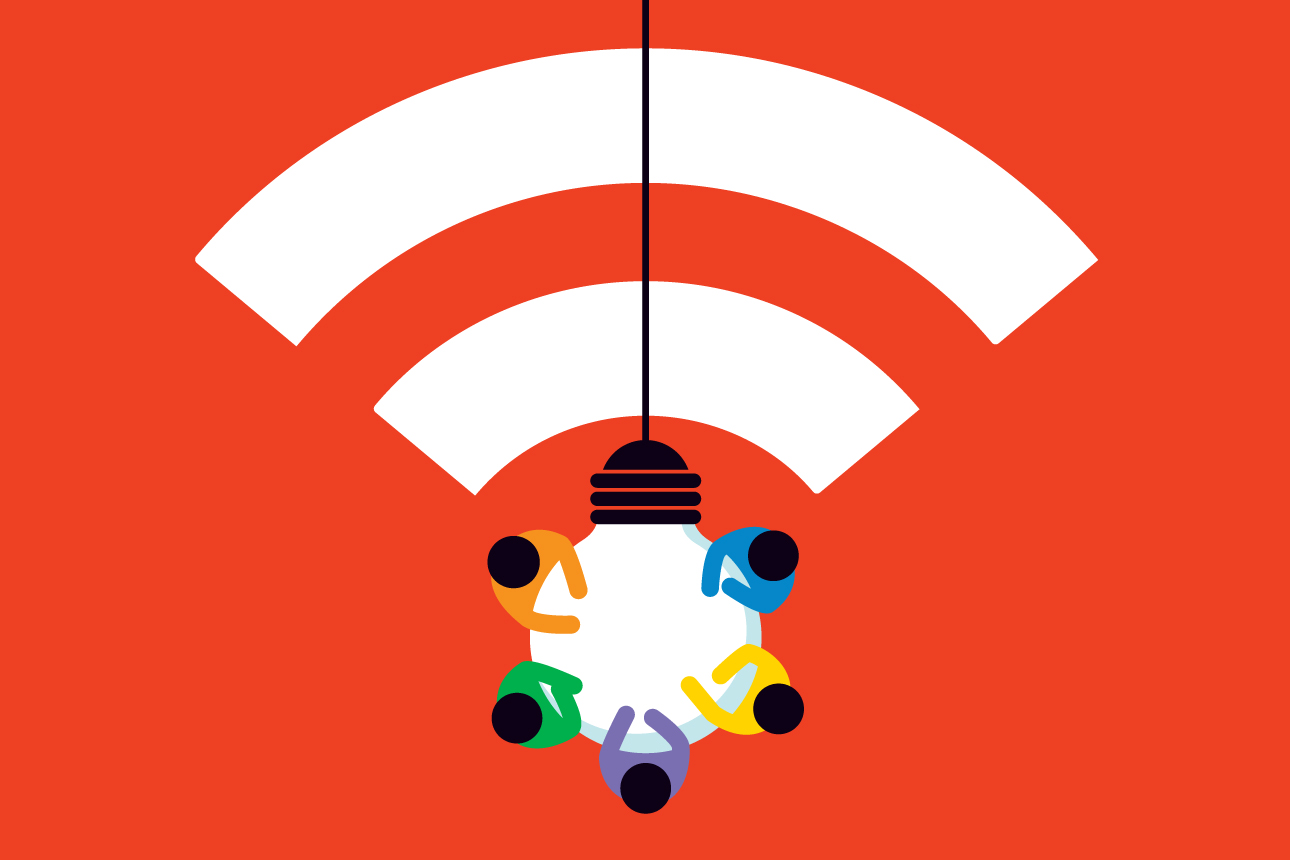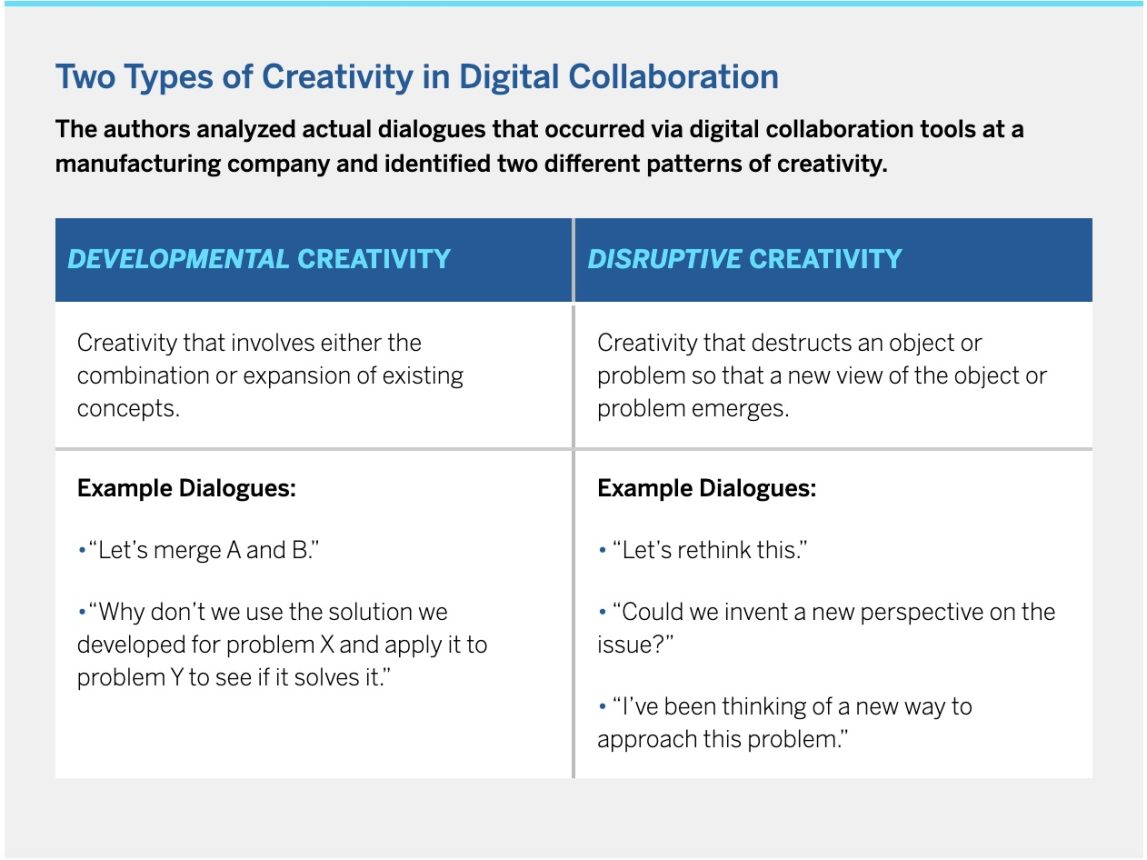The Profound Influence of Small Choices in Digital Collaboration
Simple decisions about how to use collaboration tools can set teams on a path toward either incremental or breakthrough innovations.
Topics
News
- Gulf Nations Fast-Track AI Ambitions, UAE Leads Regional Readiness, says BCG Report
- AI Professionals form a Redefined Workforce. But Systemic Roadblocks Persist, Survey Finds
- AI-Driven Scams Surge as Microsoft Blocks $4 Billion in Fraud Attempts
- Identity-based Attacks Account for 60% of Leading Cyber Threats, Report Finds
- CERN and Pure Storage Partner to Power Data Innovation in High-Energy Physics
- CyberArk Launches New Machine Identity Security Platform to Protect Cloud Workloads

Patrick George/MIT SMR
The widespread shift to remote work over the past several years has made digital collaboration tools increasingly essential to employee communication and coordination. Many managers worry that a decrease in face-to-face interactions between employees could be suppressing creativity and innovation, and they are relying on software such as enterprise social media and chat tools to help knowledge workers, in particular, come together. But how do the features of these platforms affect the direction of creative collaboration, and how can managers help teams use them in ways that support the type of collaboration that will be most productive in a given case?
We sought to investigate these questions, focusing on how the use of such tools affected two dynamics that previous research has shown influence the process and outcomes of creative teams and problem-solving: transparency and privacy. Groups working transparently within a larger organization engage with a broader community, including through spontaneous encounters with previously unknown colleagues elsewhere in the organization.1 They develop bridging relationships with diverse individuals and are exposed to fresh perspectives, which may help creativity.2 On the other hand, creative teams that choose to work together privately benefit from a safe space characterized by a sense of trust that fosters authenticity and creative deviance, risk-taking, and idea incubation, which may also help create space for innovation.3 Working in this way fosters bonding ties, cementing a shared identity that may produce stronger motivation to contribute and engage.4
Organizational choices between privacy and transparency have played out through changing fashions in physical workplace design. In recent years, open-plan offices have replaced high-walled cubicle farms, but such configurations have faced pushback from employees who find open environments distracting for focused work. The digital environment, however, permits more flexibility: Platforms such as Slack or Microsoft Teams allow groups to create either public or private channels as needed for collaboration on specific projects.
The choice to make a new group transparent via a public channel or to keep it private has important implications for whom members connect and communicate with. Each choice fosters a different type of communication structure, with different implications for creative outcomes.5
Two Paths to Digital Creativity
Our study of 215 groups using a collaborative platform at a large manufacturer shows that digital communication features (transparency versus privacy) and digital communication structures (bridging versus bonding) produce two different paths resulting in different types of creativity that we identify as developmental creativity and disruptive creativity. (See “Two Types of Creativity in Digital Collaboration.”) Developmental creativity involves combining or expanding existing concepts to produce new outcomes, and we found that it is the most likely outcome of collaborating in a public channel. Disruptive creativity involves the creative destruction of an object or problem so that a new view of the object or problem emerges. In a digital environment, this is most likely to occur when groups set their communications to private.

Managers can foster these two different types of creativity by carefully designing the two distinct paths that lead there. By combining the right communication features with the right communication structures, managers can facilitate the type of creativity that will be most useful for a particular project or project stage. Importantly, some groups may benefit from shifting from one mode into the other as an innovation project progresses.
To illustrate how different digital configurations influence whether developmental or disruptive creativity emerges, we drew from the real discussions we collected from collaboration platforms for our research. As the two examples below demonstrate, transparent groups with bridging ties produce developmental creativity, while private groups with bonding ties produce disruptive creativity. Our research suggests that when these paths are misaligned, creativity tends to stall.
The Path to Developmental Creativity
Choose transparency: John is trying to solve the problem of recycling particleboard for one of his clients. He turns to the organization’s main channel, a public group that describes itself as providing a forum to ask questions and share ideas.
Engage in bridging: John reaches out to someone who had previously mentioned in the forum that it is common to recycle particleboard in the European Union. He explains that clients in the U.S. are struggling with the problem and to date have only found ways to downcycle the material. He asks, “Can you please explain this process more?”
Outcome: Seb, a member of the global team, offers information he’s learned from his clients abroad and suggests combining recycling with energy recovery, as has been applied in Europe. The dialogue eventually shifts to developing creative solutions and expanding the use of that knowledge to help the client. From this short conversation, we see that open organizational forums like this one provide the opportunity to bridge across groups to find creative solutions to tricky problems, often through serendipity or unexpected sources. This kind of interaction enables the expansion of knowledge from one context to another.
The Path to Creative Disruption
Protect privacy: Elena leads a private group with 15 members. Its members are trying to reimagine how their organization works to make it more agile and creative and in doing so is challenging accepted ways of working. The group is protective of its privacy, and members express reservations about eventually making the group a public forum, noting that they’d prefer to keep comments they’ve made in the forum away from a larger audience.
Encourage bonding: The members of the group are keenly aware of their bond and praise the “common language” and “sense of community” that they have been able to build. Elena notes that working as a group in this shared space allows them to discuss a philosophy of work with a specific vocabulary and concepts, and to share a professional identity. Their dialogue reveals concern that eventually opening up the group to others in the organization might diminish the level of honesty and directness in communications.
Outcome: Reframing happens within this bonded group: For instance, the group is excited about the idea of a debate about organizational structures, calling such discussions “highly generative”; this is another indication that the safety of a private group promotes more argumentative discourse that can yield new ideas. From the team’s exchanges, we can see that a private group provides bonding opportunities that not only establish a sense of safety and shared mission but also enable greater risk-taking, a focus on reframing questions, and creative disruption.
Designing Digital Groups for Creativity
The interactions that we studied among the users of digital collaboration tools show that they are uniquely suited for facilitating collaborative creativity. With the growing digitization of workplaces, further amplified by a preference for remote or hybrid working arrangements among knowledge workers, the challenge for organizations is to understand the demands of different projects and choose the right paths to creativity accordingly. That requires strategically combining different features of the collaboration tools in use with the appropriate communication structures. Here are three points for managers to consider in doing so:
1. Choose collaboration tools that allow both public and private spaces. The type of creative output that a problem requires can guide decisions on the kind of group needed. If a new project is likely to involve incrementally improving an existing product or process — that is, developmental creativity — enabling a transparent group with bridging ties that encourage connecting with serendipitous and diverse perspectives is the ideal path to follow. On the other hand, a novel challenge with lots of uncertainty — disruptive creativity — is best enabled through a private group with bonding ties that allow for safety and shared identity.
2. Managers should consider how to support private groups that they can’t see or monitor, and how to make the knowledge embedded in these groups available to the broader organization. Organizations should try to create opportunities for organizationwide learning from the creative deviance that happens in private spaces, but without undermining the safety and sense of shared mission that form the conditions for disruptive creativity to emerge. Managers must be willing to place trust in the process and let it evolve organically, even if it is invisible and thus outside of their control. Managers leading transparent groups could similarly support creative risk-taking when needed by facilitating secret conversations from time to time. To ensure that learning is ultimately accessible to others in the organization, creators of these private groups should be encouraged to find ways to transfer what they learn — for instance, by establishing an open group for sharing news and updates about the group’s activities.
3. Organizations can combine different groups to create multiple pathways to different types of creativity. Digital tools offer a unique opportunity to real-world groups to create multiple distinct digital spaces that could be managed simultaneously or sequentially to support different types of creativity. For instance, Elena’s group discussed creating a second, public group following the creation of a minimum viable process, in order to “get out of the strategy room” and “connect with key stakeholders in the organization” to “test their assumptions and turn them into knowledge.” Hence, having a private group facilitates an initial stage of disruptive creativity that can be followed by a secondary stage of development creativity enabled through a public group. Likewise, for public projects that require some experimentation and idea incubation, managers could encourage groups to “withdraw” into private enclaves temporarily to foster greater risk-taking.
As managers wonder how to foster creativity and innovation in the digital workplace, understanding the unique opportunities that digital tools afford for creativity is critical. Different communication features of these tools — especially those that enable transparency versus privacy — produce distinct paths to creativity that ultimately amount to developmental or disruptive forms of creativity. Leaders need to be mindful that there is no one-size-fits-all approach to innovation. What is most effective depends on the scope of ambition and the stage of the innovation process. They must empower users to blend and embrace multiple paths to creativity, and leverage these paths for maximizing the creative potential of their digital workforce.
References
- P.S. Adler and K.B. Clark, “Behind the Learning Curve: A Sketch of the Learning Process,” Management Science 37, no. 3 (March 1991): 267-281; and L. Argote, P. Ingram, J.M. Levine, et al., “Knowledge Transfer in Organizations: Learning From the Experience of Others,” Organizational Behavior and Human Decision Processes 82, no. 1 (May 2000): 1-8.
- R.S. Burt, “Structural Holes and Good Ideas,” American Journal of Sociology 110, no. 2 (September 2004): 349-399; and J.E. Perry-Smith, “Social Yet Creative: The Role of Social Relationships in Facilitating Individual Creativity,” Academy of Management Journal 49, no. 1 (February 2006): 85-101.
- J.P.J. de Jong, M. Mulhuijzen, and K.V. Prasad, “Mining Underground Innovation,” MIT Sloan Management Review 64, no. 3 (spring 2023): 50-55; and E.S. Bernstein, “The Transparency Paradox: A Role for Privacy in Organizational Learning and Operational Control,” Administrative Science Quarterly, 57, no. 2 (June 2012): 181-216.
- J.S. Coleman, “Social Capital in the Creation of Human Capital,” American Journal of Sociology 94 (1988): S95-S120; R. Reagans and E.W. Zuckerman, “Networks, Diversity, and Productivity: The Social Capital of Corporate R&D Teams,” Organization Science 12, no. 4 (July-August 2001): 502-517; and J. Dyer, N. Furr, C. Lefrandt, et al., “Why Innovation Depends on Intellectual Honesty,” MIT Sloan Management Review 64, no. 3 (spring 2023): 66-72.
- Y. Kim, S.L. Jarvenpaa, and B. Gu, “External Bridging and Internal Bonding: Unlocking the Generative Resources of Member Time and Attention Spent in Online Communities,” MIS Quarterly 42, no. 1 (March 2018): 265-284.





